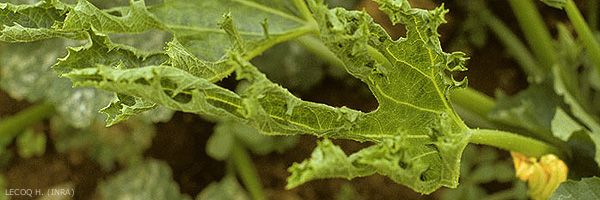
Papaya ringspot virus (PRSV)
Papaya ring spot virus
(Potyvirus, Potyviridae)
PRSV is a potyvirus transmitted by aphids in the non-persistent mode. It is quite rarely encountered in mainland France, except in late cultivation. It is however regularly observed in the Nice region, in Guadeloupe or Martinique. More generally, it is present all over the world, in hot regions ranging from the Mediterranean climate to the tropical climate. It causes severe symptoms in Cucurbits which can lead to total loss of crops.
This virus was first described in California in 1965, but for almost 20 years there was some confusion about it. Indeed, it was first considered to be a strain of WMV, WMV1 . Serological studies have shown that WMV1 was in fact very close and therefore a strain of PRSV, a papaya virus causing ring spots on the fruits of this plant.
Several strains of PRSV can be distinguished today. The PRV-P (for papaya) causes a serious disease of papaya and symptoms rather low on Cucurbitaceae. The PRV-W (for watermelon, watermelon) causes very strong symptoms in Cucurbitaceae, but does not infects papaya. It is the most frequently encountered strain of melon in the world. The PRV-T (for Tiger, because of symptoms stripes on the leaves) was isolated zucchini in Guadeloupe. Since then PRSV-T has been reported in Martinique, Venezuela, Reunion, Mauritius, and several other countries.
Three distinct viral species, but close to PRSV, can be found in Cucurbitaceae in France or in neighboring countries. The Zucchini yellow fleck virus (ZYFV) virus or yellow flecks of zucchini is present in several countries of the Mediterranean Basin. In France it has been isolated from Bryone and Ecballium, two wild Cucurbitaceae, and very occasionally from zucchini. The Moroccan watermelon mosaic virus Moroccan watermelon mosaic virus (MWMV) or is quite common in Africa. It was isolated from zucchini in the South-West of France in 2003, then in the South-East in 2009-2010, without being found in the following years. The MWMV therefore does not seem to have settled in France for the moment, but it could be the case in the years to come. Finally, the ' Algerian watermelon mosaic virus watermelon mosaic virus (AWMV) or Algeria-type is quite common in Algeria, the only country where it has been reported so far. These three viruses have in common that they cause necrotic-type symptoms in Charentais-type melons: necrotic lesions on leaves and necrotic stripes on stems which spread rapidly, causing the plant to dry out and die. In other varietal types (Canary, for example) the symptoms will be deforming mosaics.
PRSV has flexible particles of approximately 780 x 12 nm and its genome is in the form of a positive single-stranded RNA molecule.
Many viruses cause mosaics in Cucurbits, which makes often visual diagnosis difficult . Commercial DAS-ELISA diagnostic kits are available, but some of them may cross-react * with MWMV and AWMV. Primers are available for molecular diagnosis by RT-PCR. The distinction between the different strains of PRSV can be made by biological tests or by partial sequencing of the genome. The ability to infect papaya is determined by a single mutation in the NIa-Pro protein.
* We speak of a cross-reaction in a serological test when an antiserum against a virus (here PRSV) can also react, but more weakly, with another virus (here MWMV). This cross reaction usually indicates that these viruses are very similar at the molecular level.





